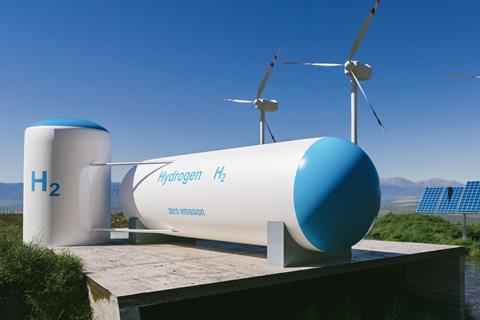Hydrogen is seen as the Swiss Army knife of net zero solutions – but is it really?

In recent years, the intensifying activity around net zero and decarbonising modern life in the UK has clearly demonstrated the significant challenge at hand. Hydrogen is the most abundant element on the planet and has been described as the Swiss Army knife of net zero solutions, with capabilities such as energy delivery, storage and generation. However, there is a danger in viewing it as a silver bullet solution to the UK’s carbon and climate concerns.
As an energy source, hydrogen does not produce any greenhouse gas output. However, to obtain pure hydrogen requires energy input to separate it from other elements (whereas fossil fuels are mined or drilled our directly). Therefore, while hydrogen could be used in many of the processes for which we use fossil fuels today but with no greenhouse gas emissions, the process itself requires more energy than required to get to the same point with fossil fuels. This ultimately means that hydrogen will cost more than fossils fuels do today.
Why is hydrogen such a strong contender in the UK?
Net zero solutions tend to have a local aspect to them, making them favourable to certain locations. Wind is prevalent in coastal areas, solar in sunny countries and hydroelectric power near rivers, for instance. Hydrogen is similar in this regard for the UK, making it a consideration for our net zero toolbox. The UK’s domestically produced natural gas supply could be used for steam methane reforming (SMR), and access to closed gas fields with subterranean caverns could be repurposed to store the carbon dioxide (a process called carbon capture and storage) produced from the SMR process, thus forming blue hydrogen.
Carbon capture and storage technology, which is required for blue hydrogen production, is immature at scale and faces advancement challenges
The UK is also forging ahead with offshore wind installation and investment, with strong targets of more than 100GW of offshore supply by 2050, which could provide excess electrical power to generate green hydrogen through an electrolysis process. Hydrogen specialist ITM Power completed the world’s largest PEM electrolyser factory in Sheffield earlier this year.
Existing locally based knowledge and development experience provides the UK with an opportunity to work towards further efficiency gains, improving the attractiveness of hydrogen. These elements of the hydrogen development supply chain all represent potential areas of domestically generated green jobs, driving the UK’s green workforce.
What’s the catch?
Today’s estimates for hydrogen consumption in the energy mix of the UK by 2050 range from 211TWh/yr (low scenario) to 515TWh/yr (high scenario). Taking green hydrogen, if the entire expected offshore wind electrical capacity in 2050 was converted into hydrogen, considering conversion losses this would produce around 198TWh of final energy use. This represents 41% of the transport sector energy demand in 2018, or 56% of space heating and hot water heating energy demand for households in 2018. For green hydrogen this demonstrates its limitations in meeting all fossil fuel supplied energy today, in addition to the need for the renewable wind electricity generated offshore.

Blue hydrogen has different constraints. Carbon capture and storage (CCS) technology, which is required for blue hydrogen production, is immature at scale and faces advancement challenges. Last year NRG Energy announced it was to indefinitely close its $1bn Petra Nova power plant, the only project capturing carbon from a coal-fired generator that had been operating in the US. Today the UK is a net importer of natural gas, required for almost 50% of national demand.
These limitations on resources and technologies needed to generate enough hydrogen to replace fossil fuels indicate that it should only be used where most needed.
Where next?
Considering the sectors and potential available solutions, such as electrical batteries for domestic vehicles and air-source heat pumps or heat networks for space heating, hydrogen is unlikely to compete on cost and ease of use. But green and blue hydrogen are likely to have a function in harder-to-abate sectors such as heavy transport, shipping and aviation, or where access to local resources (such as subterranean caverns) make it an attractive solution. For these sectors, it is most likely that green hydrogen will be synthesised into other, more energy-dense compounds such as methanol, ammonia and sustainable aviation fuel.
In the agriculture sector, grey hydrogen is already being used to create ammonia used in fertiliser for food production, using steam methane reforming technology. Ammonia currently emits more than 1% of the world’s global greenhouse gas emissions so decarbonising its production using the UK’s natural resources for hydrogen production could provide a key export and economic opportunity, as well as a significant impact on emissions globally. Furthermore, hydrogen could provide the opportunity to decarbonise high-temperature industrial heat processes, which currently have no viable alternative to fossil fuels.
Work on hydrogen production is being explored with numerous pilot studies in the UK, including the recently announced 20MW green hydrogen plant proposed for Glasgow. Equally optimal uses for hydrogen are being tested to see where it could have most impact. It is clear from the work done and proposed by the greater hydrogen community that subsidies and clear direction will be needed to steer hydrogen towards its optimum function and that, while it should not be positioned as the ultimate solution, it is a key piece of the decarbonisation puzzle.
Isidore McCormack is chief project manager, Energy, Ramboll


























No comments yet